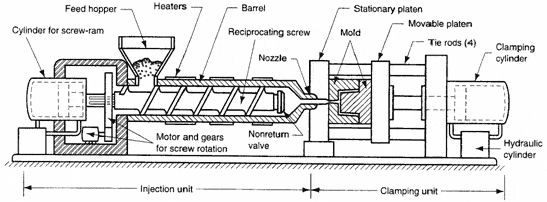Injection molding is a process in which a polymer is heated to a highly plastic state and forced to flow under high pressure into a mold cavity, where it solidifies. The molded part, called a molding, is then removed from the cavity. The process produces discrete components that are almost always net shape. The production cycle time is typically in the range 10 to 30 seconds, although cycles of one minute or longer are not uncommon. Also, the mold may contain more than one cavity; so that multiple moldings are produced each cycle.
Complex and intricate shapes are possible with injection molding. The challenge in these cases is to design and fabricate a mold whose cavity is the same geometry as the part and which also allows for part removal. Part size can range from about 50 g (2 oz) up to about 25 kg (more than 50 lb), the upper limit represented by components such as refrigerator doors and automobile bumpers. The mold determines the part shape and size and is the special tooling in injection molding. For large complex parts, the mold can cost hundreds of thousands of dollars. For small parts, the mold can be built to contain multiple cavities, also making the mold expensive. Thus, injection molding is economical only for large production quantities.
Injection molding is the most widely used molding process for thermoplastics. Some thermosets and elastomers are injection molded, with modifications in equipment and operating parameters to allow for cross-linking of these materials.
Process and Equipment
Equipment for injection molding evolved from metal die casting. An injection molding machine consists of two principal components: (1) the plastic injection unit and (2) the mold clamping unit. The injection unit is much like an extruder. It consists of a barrel that is fed from one end by a hopper containing a supply of plastic pellets. Inside the barrel is a screw whose operation surpasses that of an extruder screw in the following respect: in addition to turning for mixing and heating the polymer, it also acts as a ram which rapidly moves forward to inject molten plastic into the mold. A nonreturn valve mounted near the tip of the screw prevents the melt from flowing backward along the screw threads. Later in the molding cycle the ram retracts to its former position. Because of its dual action, it is called a reciprocating screw, which name also identifies the machine type. Older injection molding machines used a simple ram (without screw flights), but the superiority of the reciprocating screw design has led to its widespread adoption in today’s molding plants. To summarize, the functions of the injection unit are to melt and homogenize the polymer, and then inject it into the mold cavity.
The clamping unit is concerned with the operation of the mold. Its functions are to (1) hold the two halves of the mold in proper alignment with each other; (2) keep the mold closed during injection by applying a clamping force sufficient to resist the injection force; and (3) open and close the mold at the appropriate times in the molding cycle. The clamping unit consists of two platens, a fixed platen and a movable platen, and a mechanism for translating the latter. The mechanism is basically a power press that is operated by hydraulic piston or mechanical toggle devices of various types. Clamping forces of several thousand tons are available on large machines.

The cycle for injection molding of a thermoplastic polymer proceeds in the following sequence. Let us pick up the action with the mold open and the machine ready to start a new molding: (1) Mold is closed and clamped. (2) A shot of melt, which has been brought to the right temperature and viscosity by heating and by the mechanical working of the screw, is injected under high pressure into the mold cavity. The plastic cools and begins to solidify when it encounters the cold surface of the mold. Ram pressure is maintained to pack additional melt into the cavity to compensate for contraction during cooling. (3) The screw is rotated and retracted with the nonreturn valve open to permit fresh polymer to flow into the forward portion of the barrel. Meanwhile, the polymer in the mold has completely solidified. (4) The mold is opened, and the part is ejected and removed.
No comments:
Post a Comment